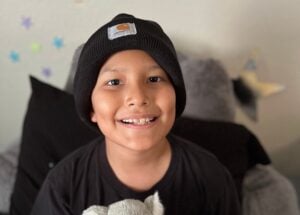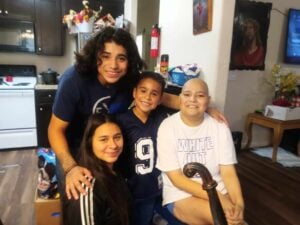
Sights Set on a Strong End to 2023 — Will You Join Us?
Family Reach CEO Carla Tardif reflects on 2023 and calls for community support before the year ends.
Worrying about keeping food on the table or a roof over your head should not be part of anyone’s cancer journey — yet it’s the reality for far too many families.
The first step in solving this crisis is amplifying the conversation around the financial side of cancer. Science will continue to outpace the cancer patient journey if we don’t step in to address to the barriers that prevent treatment access and adherence.
Here’s a roundup of the latest perspectives and research adding to these important discussions.
In collaboration with Kaiser Health News, NPR shared the story of a mother and foster parent, Jeni Peters, whose cancer experience led to impossible choices about her and her children’s well-being.
“Do I pull them out of day care? Do I stop their schooling and tutoring? Do I not help them with college?” Peters asked herself. “My doctor saved my life, but my medical bills are stealing from my children’s lives.”
Jeni’s situation is far too familiar to Family Reach. The families we support are worried about making ends meet while going through cancer treatment and our comprehensive financial services are there to relieve the stress. It takes a village, but we have to prioritize financial health in cancer care because survival requires basic needs like housing, food, and overall well-being.
With polls, data, and quotes from oncologists, this article builds on stories like Jeni’s for a comprehensive picture of the financial crisis of cancer in the United States.
Though breakthroughs in cancer medications increase survival rates, they also leave patients with devastating financial burdens. Too often patients overcome cancer yet they cannot escape the lingering debt.
In fact, Nikki Yulli from the Leukemia & Lymphoma Society shared that “people tell us they won’t get follow-up care because they can’t take on more debt.”
“I can’t imagine my daughter not getting important cancer treatments because we could not afford it or because insurance denied it,” writes Debbie, who cared for her daughter when she was diagnosed with breast cancer. She goes on to consider the reality that not all patients have the same access to the latest cancer treatments.
From the moment of diagnosis, social determinants of health that are beyond a patient’s control — including race, ethnicity, income level, zip code, and language — can create financial and clinical barriers to cancer care. A patient’s background should not define their chance of survival, but it often does.
Life-saving treatments only matter if people can access and afford them, which is why increasing cancer equity is key to improving patient outcomes.
In this column, Anita Chabria puts two cancer stories in conversation — one of her own family and another of Primo Castro, who lost his mother to gallbladder cancer nearly 20 years ago.
Chabria’s husband has been cancer free for over a decade, with many thanks to a comprehensive cancer center with “cutting-edge medicine and best-of-the-best doctors.” In contrast, Primo’s mom, Maria, was unable to access a recommended clinical trial because the facility didn’t take her insurance. She sadly passed away eight months later.
Today, state legislators in Sacramento are working on a senate bill to repair the systemic issues that prevented Maria from accessing life-saving care.
Solving the financial crisis of cancer takes all of us, and it’s encouraging to see public officials taking steps toward a healthcare system where socioeconomic factors do not determine survival.
According to this recent study, Black and Latinx adults in the US experienced higher rates of delayed cancer care and more adverse social and economic effects than White adults during the COVID-19 pandemic.
Here at Family Reach, we’re still seeing the disparate effects of the COVID-19 pandemic on families facing cancer. The rising prices of gas, food, electricity, and other basic needs, for example, create significant barriers to treatment for families who were already struggling to keep up with the bills.
As the pandemic continues to expose disparities and add to the financial hardships of cancer, we’re committed to making our services accessible to patients with the deepest needs.

As Communications Coordinator, Mary creates and promotes content that spreads the word about Family Reach’s mission. Mary brings her love of storytelling to her work, and a commitment to a world where socioeconomic status doesn’t determine chances of survival.

Family Reach CEO Carla Tardif reflects on 2023 and calls for community support before the year ends.

Your holiday giving provides financial relief to families like these who are facing cancer this winter.

Curious what a donation to Family Reach does? Here’s a breakdown of how donations to Family Reach provide financial support to families facing cancer.
Applications will only be reviewed and processed for open funds.
Applications will only be reviewed and processed for open funds.
Applications will only be reviewed and processed for open funds.
Applications will only be reviewed and processed for open funds.
Applications will only be reviewed and processed for open funds.
Join our email list for updates about our events, fundraising campaigns, family stories, partnerships, and the impact of your generous support.